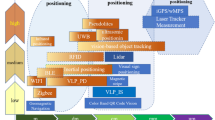Abstract
An indoor visible light positioning system using the received signal strength intensity method and the trilateration technique with user mobility support is proposed for applications, e.g. healthcare. Accurate position information of medical staffs and patients is required for data transmission, tracking, navigation, etc. Seamless data transmission while user is on the move has been conceptualized considering the optical network formed by photosensor (light emitting diode)-based transmitters. Efficiency of these services depends on the position accuracy. To investigate factors contributing to higher position errors in a practical environment, the proposed system is evaluated. Evaluation is done through simulation and experiment for different channel conditions, and the receiver rotation due to user mobility. Simulation results show an average two-dimensional position error of 0.32 m in a channel with a strong background light illumination level of − 60 dBm. Experimental results show that the mean position error is 0.7 m in a normal daytime indoor light condition.























Similar content being viewed by others
References
Spectrum Crunch: The cell phone industry hits its limits (2012) http://money.cnn.com/2012/02/21/technology/spectrum_crunch/index.htm
Bahl P, Padmanabhan VN (2000) RADAR: an in-building RF-based user location and tracking system. In: IEEE INFOCOM, 19th annual joint conference of the IEEE computer and communications societies, vol 2, Tel Aviv, pp 775–784 https://doi.org/10.1109/infcom.2000.832252
Chintalapudi K, Iyer AP, Padmanabhan VN (2010) Indoor localization without the pain. ACM MOBICOM. https://doi.org/10.1145/1859995.1860016
Komine T, Nakagawa M (2004) Fundamental analysis for visible-light communication system using LED lights. IEEE Trans Consum Electron. https://doi.org/10.1109/TCE.2004.1277847
Li L, Hu P, Peng C, Shen G, Zhao F (2014) Epsilon: a visible light based positioning system. In: Proceedings of 11th USENIX conference on networked systems design and implementation, NSD’14, pp 331–343, ISBN: 978-1-931971-09-6
Yamaguchi S et al (2014) Design and performance evaluation of VLC indoor positioning system using optical orthogonal codes. In: Proceedings of 5th IEEE international conference on communications and electronics (ICCE), pp 54–59. https://doi.org/10.3390/computation7010007
Hussein AT, Elmirghani JMH (2015) Mobile multi-gigabit visible light communication systems in realistic indoor environment. IEEE J Light Wave Technol 33(15):3293–3307. https://doi.org/10.1109/FJLT.2015.2439051
Kavehrad M (2010) Sustainable energy-efficient wireless applications using light. IEEE Commun Mag. https://doi.org/10.1109/MCOM.2010.5673074
Iturralde D, Soto I, Azurdia C, Krommenacker N, Ghassemlooy Z, Becerra N (2014) A new location system based on space–time codes in an underground environment using visible light communications. In: 9th international symposium on communication systems, networks and digital signal processing (CSNDSP), pp 1165–1169, Manchester, UK. https://doi.org/10.1109/FCSNDSP.2014.6924006
Alavikia Z, Khadivi P, Hashemi MR (2012) A model for QoS-aware wireless communication in hospitals. J Med Signals Sens 2(1):1–10. https://doi.org/10.4103/2228-7477.103140
Lou X, O’Brien WJ, Julien CL (2011) Comparative evaluation of received signal-strength index (RSSI) based indoor localization techniques for construction jobsites. Adv Eng Inform Inf Min Retrieval Des 25(2):355–363. https://doi.org/10.1016/j.aei.2010.09.003
Cossu G, Presi M, Corsini R, Choudhury P (2011) A visible light communication aided optical wireless system. IEEE Globecomm workshop, pp 802–807. https://doi.org/10.1109/GLOCOMW.2011.6162565
Kim HS, Kim DR, Yang SH, Son YH, Han SK (2013) An indoor visible light communication positioning system using a RF carrier allocation technique. J Lightwave Technol. https://doi.org/10.1109/JLT.2012.2225826
Zhou Z, Kavehrad M, Deng P (2012) Indoor positioning algorithm using light-emitting diode visible light communications. Opt Eng 51(8):085009. https://doi.org/10.1117/1.OE.51.8.085009
Schmid S, Corbellini G, Mangold S, Gross TR (2013) LED-to-LED visible light communication networks. In: Proceedings of the 14th ACM international symposium on mobile ad hoc networking and computing, (MOBIHOC), pp 1–10. https://doi.org/10.1145/2491288.2491293
Ghassemlooy Z, Poopoola W, Rajbhandari S (2012) Optical wireless communications: system and channel modelling with MATLAB. CRC Press, Cambridge. https://doi.org/10.1201/b12687
Haas H, Liang Y, Wang Y, Chen C (2015) What is Li Fi? IEEE J Light Wave Technol. https://doi.org/10.1109/JLT.2015.2510021
Enck W, Gilbert P, Han S, Tendulkar V, Chun BG, Cox LP, Jung J, McDaniel P, Sheth AN (2014) TaintDroid: an information-flow tracking system for realtime privacy monitoring on smartphones. Commun ACM 57(3):99–106. https://doi.org/10.1145/2619091
Mejia DA, Favela J, Moran AL (2010) Understanding and supporting lightweight communication in hospital work. IEEE Trans Inf Technol Biomed. https://doi.org/10.1109/TITB.2009.2033384
Sruthi K, Kripesh EV, Unnikrishna Menon KA (2017) A survey of remote patient monitoring systems for the measurement of multiple physiologial parameters. Health Technol 7(2–3):153–159. https://doi.org/10.1007/s12553-016-0171-1
Thirugnanam T, Ghalib MR (2020) A new healthcare architecture using IoV technology for continuous health monitoring system. Health Technol. https://doi.org/10.1007/s12553-019-00306-7
Schiller JH (2003) Mobile communications. Pearson Education Limited, London
Siau K (2003) Health care informatics. IEEE Trans Inf Technol Biomed. https://doi.org/10.1109/TITB.2002.805449
Biswas S, Neogy S (2010) A mobility based checkpointing protocol for mobile computing system. Int J Comput Sci Inf Technol 2(1):135–151
Rahaim MB, Vegni AM, Little TDC (2011) A hybrid radio frequency and broadcast visible light communication system. IEEE Globecom Workshops. https://doi.org/10.1109/GLOCOMW.2011.6162563
Author information
Authors and Affiliations
Corresponding author
Additional information
Publisher's Note
Springer Nature remains neutral with regard to jurisdictional claims in published maps and institutional affiliations.
Rights and permissions
About this article
Cite this article
Biswas, S., Ghassemlooy, Z., Le-Minh, H. et al. On Application of a Positioning System Using Photosensors with User Mobility Support in HealthCare System. Proc. Natl. Acad. Sci., India, Sect. A Phys. Sci. 93, 121–133 (2023). https://doi.org/10.1007/s40010-022-00792-x
Received:
Revised:
Accepted:
Published:
Issue Date:
DOI: https://doi.org/10.1007/s40010-022-00792-x




